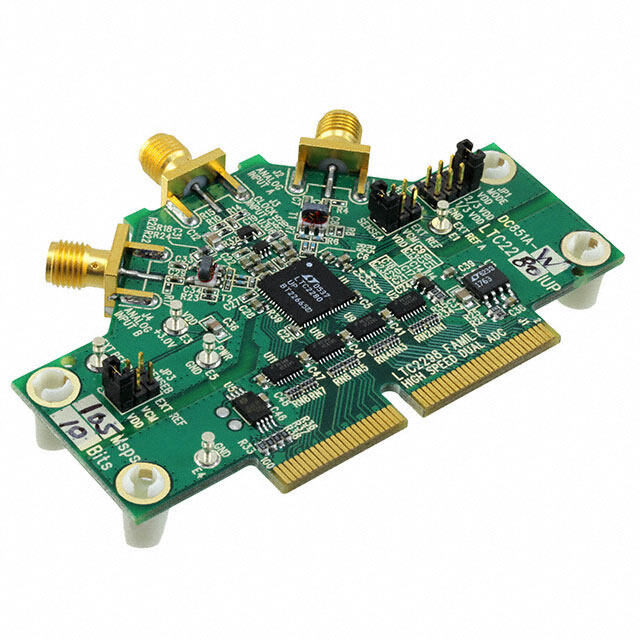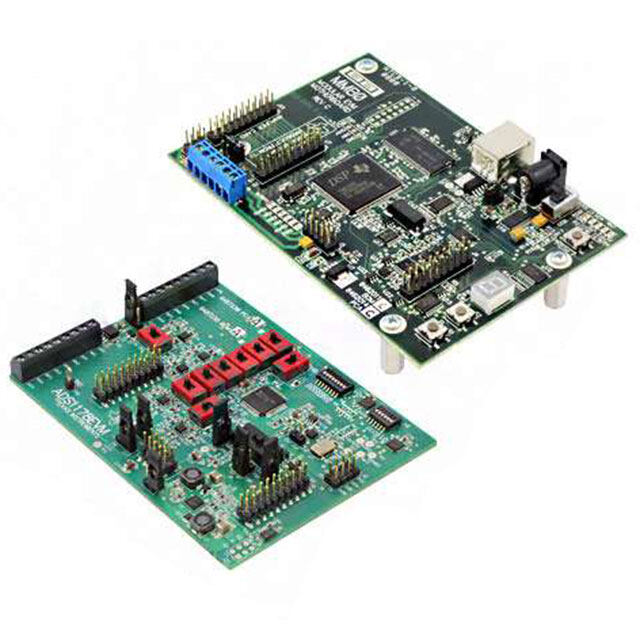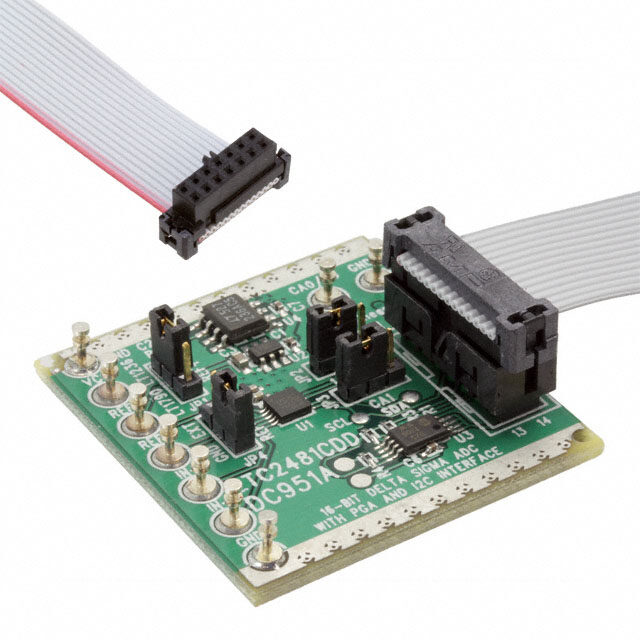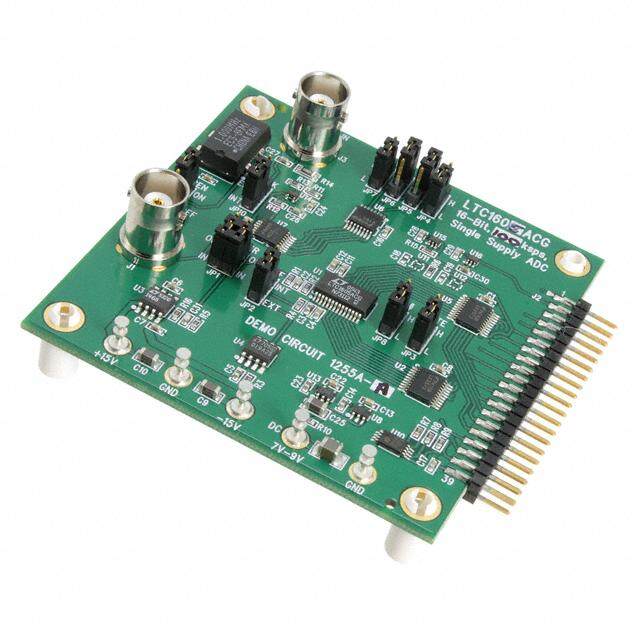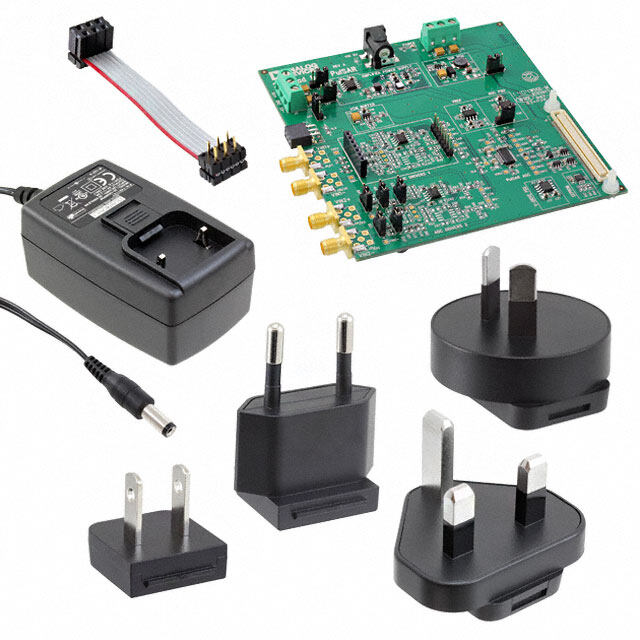ICGOO在线商城 > 开发板,套件,编程器 > 评估板 - 模数转换器(ADC) > MCP3422EV
- 型号: MCP3422EV
- 制造商: Microchip
- 库位|库存: xxxx|xxxx
- 要求:
| 数量阶梯 | 香港交货 | 国内含税 |
| +xxxx | $xxxx | ¥xxxx |
查看当月历史价格
查看今年历史价格
MCP3422EV产品简介:
ICGOO电子元器件商城为您提供MCP3422EV由Microchip设计生产,在icgoo商城现货销售,并且可以通过原厂、代理商等渠道进行代购。 MCP3422EV价格参考¥142.68-¥142.68。MicrochipMCP3422EV封装/规格:评估板 - 模数转换器(ADC), MCP3422 PICkit™ 18 Bit 3.75 Samples per Second Analog to Digital Converter (ADC) Evaluation Board。您可以下载MCP3422EV参考资料、Datasheet数据手册功能说明书,资料中有MCP3422EV 详细功能的应用电路图电压和使用方法及教程。
MCP3422EV 是 Microchip Technology 推出的一款评估板,主要用于测试和评估 MCP3422 模数转换器(ADC)的性能。MCP3422 是一款高精度、低功耗的 18 位 ΔΣ ADC,支持 I²C 接口,广泛适用于需要高分辨率和高精度数据采集的应用场景。以下是 MCP3422EV 的典型应用场景: 1. 工业自动化与控制 - 在工业自动化领域,MCP3422EV 可用于评估温度、压力、流量等传感器信号的采集精度。 - 例如,通过连接热电偶或 RTD(电阻温度检测器),可以实现高精度的温度监测。 - 还可用于评估电机控制中的电流和电压信号。 2. 医疗设备 - 在医疗设备中,如心电图(ECG)、血压计或血糖仪,MCP3422EV 可帮助开发人员评估其对微弱生物电信号的采集能力。 - 高分辨率和低噪声特性使其适合于需要精确测量人体生理信号的应用。 3. 环境监测 - MCP3422EV 可用于评估环境监测系统中的传感器数据采集,如空气质量监测、湿度监测或水质量分析。 - 其高精度特性能够确保对环境参数的细微变化进行准确捕捉。 4. 能源管理 - 在智能电网或能源管理系统中,MCP3422EV 可用于评估电力参数(如电压、电流)的高精度测量。 - 它可以帮助开发人员优化能量消耗监控系统,提高能源使用效率。 5. 消费电子 - 在高端消费电子产品中,如智能家居设备或可穿戴设备,MCP3422EV 可用于评估用户交互信号(如触摸感应或手势识别)的采集性能。 - 其低功耗特性非常适合电池供电的便携式设备。 6. 汽车电子 - 在汽车电子领域,MCP3422EV 可用于评估车载传感器(如油压、胎压或温度传感器)的数据采集精度。 - 其高可靠性和稳定性使其适合在复杂环境下工作。 总结 MCP3422EV 提供了一个便捷的平台,使开发人员能够快速评估 MCP3422 ADC 的性能,并验证其是否满足特定应用的需求。无论是在工业、医疗、环境还是消费电子领域,这款评估板都能为高精度数据采集系统的开发提供重要支持。
| 参数 | 数值 |
| ADC数 | 2 |
| 产品目录 | 编程器,开发系统半导体 |
| 描述 | BOARD EVAL MCP3422 PICKIT SERIAL开发板和工具包 - PIC / DSPIC MCP3422 Eval Board for PICKit Serial |
| 产品分类 | 评估板 - 模数转换器 (ADC)工程技术开发工具 |
| 品牌 | Microchip Technology |
| 产品手册 | http://www.microchip.com/Microchip.WWW.SecureSoftwareList/secsoftwaredownload.aspx?device=en538453&lang=en&ReturnURL=http://www.microchip.com/stellent/idcplg?IdcService=SS_GET_PAGE&nodeId=1406&dDocName=en538453# |
| 产品图片 |
|
| rohs | 符合RoHS无铅 / 符合限制有害物质指令(RoHS)规范要求 |
| 产品系列 | 嵌入式处理器开发工具,开发板和工具包 - PIC / DSPIC,Microchip Technology MCP3422EVPICkit™ |
| 数据手册 | http://www.microchip.com/mymicrochip/filehandler.aspx?ddocname=en536370http://www.microchip.com/mymicrochip/filehandler.aspx?ddocname=en538459 |
| 产品型号 | MCP3422EV |
| 不同条件下的功率(典型值) | - |
| 产品 | Evaluation Boards |
| 产品培训模块 | http://www.digikey.cn/PTM/IndividualPTM.page?site=cn&lang=zhs&ptm=24885 |
| 产品目录页面 | |
| 产品种类 | 开发板和工具包 - PIC / DSPIC |
| 位数 | 18 |
| 使用的IC/零件 | MCP3422 |
| 商标 | Microchip Technology |
| 工作温度 | -40°C ~ 125°C |
| 工作电源电压 | 5 V |
| 工具用于评估 | MCP3422 |
| 工厂包装数量 | 1 |
| 所含物品 | 板 |
| 接口类型 | I2C, SPI, USART |
| 描述/功能 | Evaluation board for 18 bit multi channel delta sigma analog to digital converter |
| 数据总线宽度 | 8 bit |
| 数据接口 | 串行 |
| 最大工作温度 | + 125 C |
| 最小工作温度 | - 40 C |
| 标准包装 | 1 |
| 核心 | PIC |
| 用于 | MCP3422 |
| 相关产品 | /product-detail/zh/MCP3422A0T-E%2FSN/MCP3422A0T-E%2FSNTR-ND/1680884/product-detail/zh/MCP3422A0T-E%2FMS/MCP3422A0T-E%2FMSTR-ND/1680883/product-detail/zh/MCP3422A0T-E%2FMC/MCP3422A0T-E%2FMCTR-ND/1680882/product-detail/zh/MCP3422A0-E%2FSN/MCP3422A0-E%2FSN-ND/1680881/product-detail/zh/MCP3422A0-E%2FMS/MCP3422A0-E%2FMS-ND/1680880/product-detail/zh/MCP3422A0-E%2FMC/MCP3422A0-E%2FMC-ND/1680879 |
| 输入范围 | ±2.048 V |
| 采样率(每秒) | 3.75 |

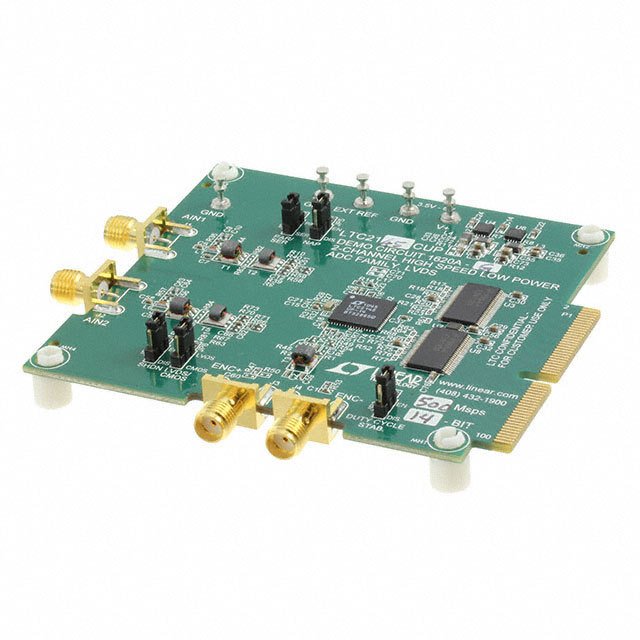
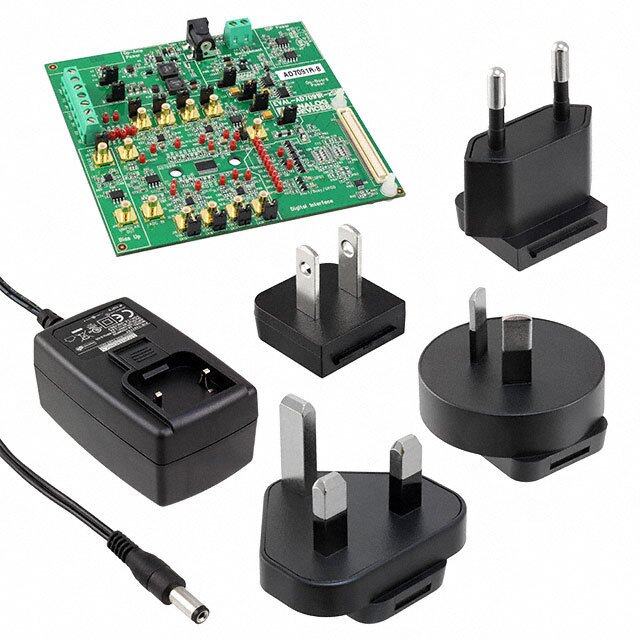
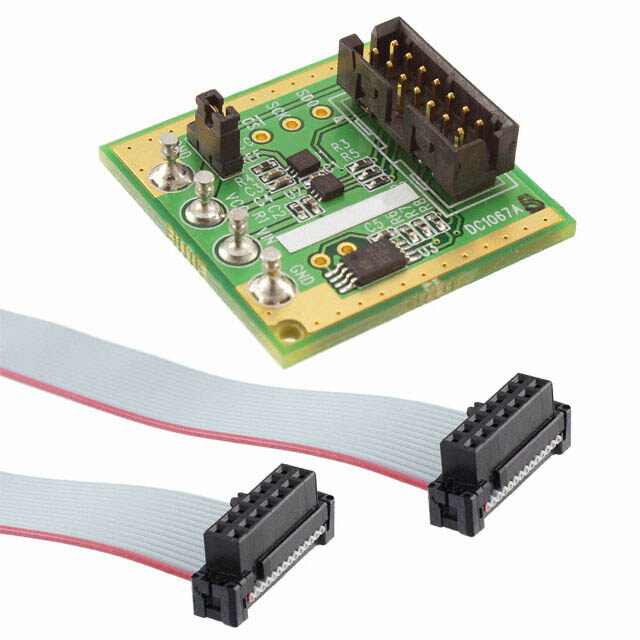
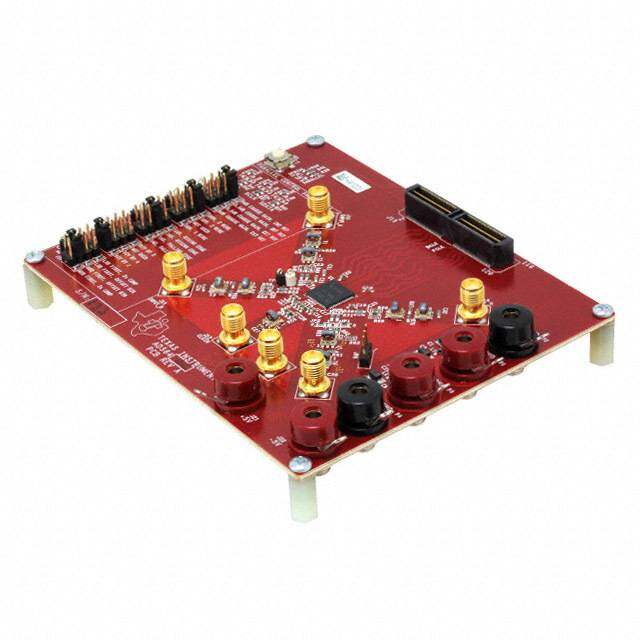
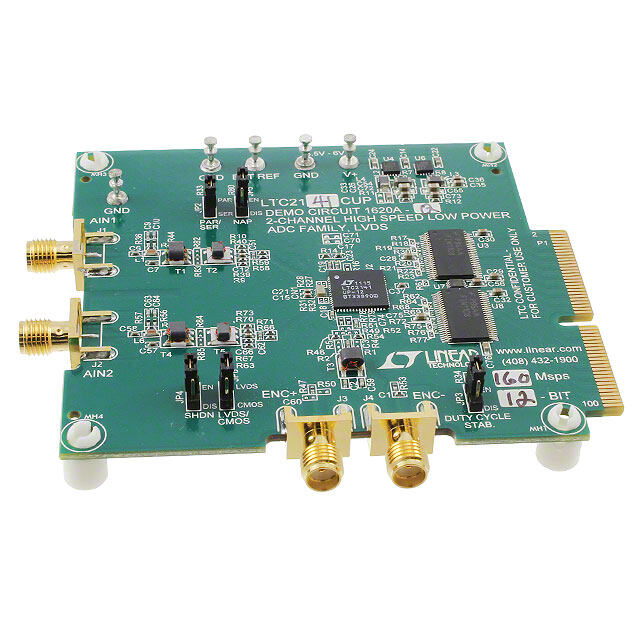

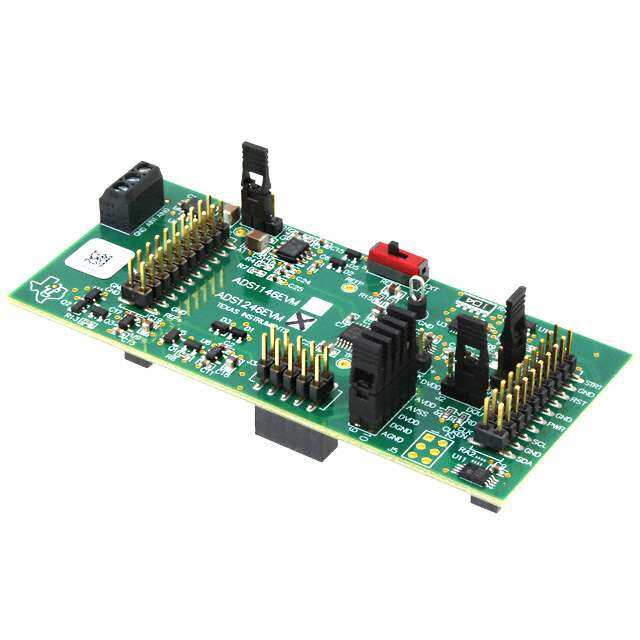
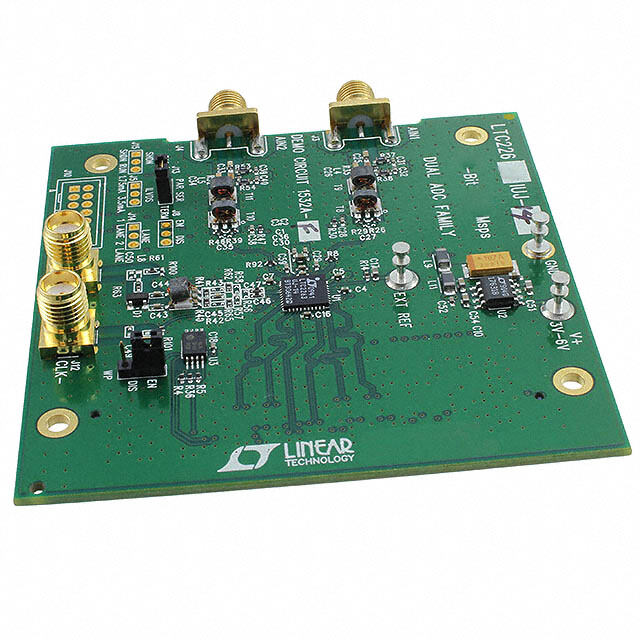

- 商务部:美国ITC正式对集成电路等产品启动337调查
- 曝三星4nm工艺存在良率问题 高通将骁龙8 Gen1或转产台积电
- 太阳诱电将投资9.5亿元在常州建新厂生产MLCC 预计2023年完工
- 英特尔发布欧洲新工厂建设计划 深化IDM 2.0 战略
- 台积电先进制程称霸业界 有大客户加持明年业绩稳了
- 达到5530亿美元!SIA预计今年全球半导体销售额将创下新高
- 英特尔拟将自动驾驶子公司Mobileye上市 估值或超500亿美元
- 三星加码芯片和SET,合并消费电子和移动部门,撤换高东真等 CEO
- 三星电子宣布重大人事变动 还合并消费电子和移动部门
- 海关总署:前11个月进口集成电路产品价值2.52万亿元 增长14.8%
PDF Datasheet 数据手册内容提取
MCP3422 Evaluation Board for PICkit™ Serial User’s Guide © 2008 Microchip Technology Inc. DS51781A
Note the following details of the code protection feature on Microchip devices: • Microchip products meet the specification contained in their particular Microchip Data Sheet. • Microchip believes that its family of products is one of the most secure families of its kind on the market today, when used in the intended manner and under normal conditions. • There are dishonest and possibly illegal methods used to breach the code protection feature. All of these methods, to our knowledge, require using the Microchip products in a manner outside the operating specifications contained in Microchip’s Data Sheets. Most likely, the person doing so is engaged in theft of intellectual property. • Microchip is willing to work with the customer who is concerned about the integrity of their code. • Neither Microchip nor any other semiconductor manufacturer can guarantee the security of their code. Code protection does not mean that we are guaranteeing the product as “unbreakable.” Code protection is constantly evolving. We at Microchip are committed to continuously improving the code protection features of our products. Attempts to break Microchip’s code protection feature may be a violation of the Digital Millennium Copyright Act. If such acts allow unauthorized access to your software or other copyrighted work, you may have a right to sue for relief under that Act. Information contained in this publication regarding device Trademarks applications and the like is provided only for your convenience The Microchip name and logo, the Microchip logo, Accuron, and may be superseded by updates. It is your responsibility to dsPIC, KEELOQ, KEELOQ logo, MPLAB, PIC, PICmicro, ensure that your application meets with your specifications. PICSTART, rfPIC, SmartShunt and UNI/O are registered MICROCHIP MAKES NO REPRESENTATIONS OR trademarks of Microchip Technology Incorporated in the WARRANTIES OF ANY KIND WHETHER EXPRESS OR U.S.A. and other countries. IMPLIED, WRITTEN OR ORAL, STATUTORY OR OTHERWISE, RELATED TO THE INFORMATION, FilterLab, Linear Active Thermistor, MXDEV, MXLAB, INCLUDING BUT NOT LIMITED TO ITS CONDITION, SEEVAL, SmartSensor and The Embedded Control Solutions QUALITY, PERFORMANCE, MERCHANTABILITY OR Company are registered trademarks of Microchip Technology FITNESS FOR PURPOSE. Microchip disclaims all liability Incorporated in the U.S.A. arising from this information and its use. Use of Microchip Analog-for-the-Digital Age, Application Maestro, CodeGuard, devices in life support and/or safety applications is entirely at dsPICDEM, dsPICDEM.net, dsPICworks, dsSPEAK, ECAN, the buyer’s risk, and the buyer agrees to defend, indemnify and ECONOMONITOR, FanSense, In-Circuit Serial hold harmless Microchip from any and all damages, claims, Programming, ICSP, ICEPIC, Mindi, MiWi, MPASM, MPLAB suits, or expenses resulting from such use. No licenses are Certified logo, MPLIB, MPLINK, mTouch, PICkit, PICDEM, conveyed, implicitly or otherwise, under any Microchip PICDEM.net, PICtail, PIC32 logo, PowerCal, PowerInfo, intellectual property rights. PowerMate, PowerTool, REAL ICE, rfLAB, Select Mode, Total Endurance, WiperLock and ZENA are trademarks of Microchip Technology Incorporated in the U.S.A. and other countries. SQTP is a service mark of Microchip Technology Incorporated in the U.S.A. All other trademarks mentioned herein are property of their respective companies. © 2008, Microchip Technology Incorporated, Printed in the U.S.A., All Rights Reserved. Printed on recycled paper. Microchip received ISO/TS-16949:2002 certification for its worldwide headquarters, design and wafer fabrication facilities in Chandler and Tempe, Arizona; Gresham, Oregon and design centers in California and India. The Company’s quality system processes and procedures are for its PIC® MCUs and dsPIC® DSCs, KEELOQ® code hopping devices, Serial EEPROMs, microperipherals, nonvolatile memory and analog products. In addition, Microchip’s quality system for the design and manufacture of development systems is ISO 9001:2000 certified. DS51781A-page ii © 2008 Microchip Technology Inc.
MCP3422 EVALUATION BOARD FOR PICkit™ SERIAL USER’S GUIDE Table of Contents Preface ...........................................................................................................................1 Introduction............................................................................................................1 Document Layout..................................................................................................1 Conventions Used in this Guide............................................................................2 Recommended Reading........................................................................................3 The Microchip Web Site........................................................................................3 Customer Support.................................................................................................3 Document Revision History...................................................................................3 Chapter 1. Quick Start Instructions 1.1 Introduction .....................................................................................................5 1.2 Description of the MCP3422 Evaluation Board ..............................................5 1.3 Getting Started with the PICkit Serial Analyzer ..............................................6 Appendix A. Schematic and Layouts A.1 Introduction ..................................................................................................21 A.2 Board Schematic ..........................................................................................22 A.3 Board – Top Layer .......................................................................................23 A.4 Board – Top Metal Layer .............................................................................24 A.5 Board – Bottom Layer .................................................................................25 Appendix B. Bill Of Materials (BOM) Worldwide Sales and Service ....................................................................................28 © 2008 Microchip Technology Inc. DS51781A-page iii
MCP3422 Evaluation Board for PICkit™ Serial User’s Guide NOTES: DS51781A-page iv © 2008 Microchip Technology Inc.
MCP3422 EVALUATION BOARD FOR PICkit™ SERIAL USER’S GUIDE Preface NOTICE TO CUSTOMERS All documentation becomes dated, and this manual is no exception. Microchip tools and documentation are constantly evolving to meet customer needs, so some actual dialogs and/or tool descriptions may differ from those in this document. Please refer to our web site (www.microchip.com) to obtain the latest documentation available. Documents are identified with a “DS” number. This number is located on the bottom of each page, in front of the page number. The numbering convention for the DS number is “DSXXXXXA”, where “XXXXX” is the document number and “A” is the revision level of the document. For the most up-to-date information on development tools, see the MPLAB® IDE on-line help. Select the Help menu, and then Topics to open a list of available on-line help files. INTRODUCTION This chapter contains general information that will be useful to know before using the MCP3422 Evaluation Board. Items discussed in this chapter include: • Document Layout • Conventions Used in this Guide • Recommended Reading • The Microchip Web Site • Customer Support • Document Revision History DOCUMENT LAYOUT This document describes how to use the MCP3422 Evaluation Board as a development tool to emulate and debug firmware on a target board. The manual layout is as follows: • Chapter 1.“Quick Start Instructions” – this chapter provides an overview of the MCP3422 Evaluation Board and instructions on how to use theMCP3422 Evaluation Board with PICkitTM Serial Analyzer. • Appendix A.“Schematic and Layouts” – shows the schematic and layout diagrams for the MCP3422 Evaluation Board. • Appendix B.“Bill Of Materials (BOM)” – lists the parts used to build the MCP3422 Evaluation Board. © 2008 Microchip Technology Inc. DS51781A-page 1
MCP3422 Evaluation Board for PICkit™ Serial User’s Guide CONVENTIONS USED IN THIS GUIDE This manual uses the following documentation conventions: DOCUMENTATION CONVENTIONS Description Represents Examples Arial font: Italic characters Referenced books MPLAB® IDE User’s Guide Emphasized text ...is the only compiler... Initial caps A window the Output window A dialog the Settings dialog A menu selection select Enable Programmer Quotes A field name in a window or “Save project before build” dialog Underlined, italic text with A menu path File>Save right angle bracket Bold characters A dialog button Click OK A tab Click the Power tab N‘Rnnnn A number in verilog format, 4‘b0010, 2‘hF1 where N is the total number of digits, R is the radix and n is a digit. Text in angle brackets < > A key on the keyboard Press <Enter>, <F1> Courier New font: Plain Courier New Sample source code #define START Filenames autoexec.bat File paths c:\mcc18\h Keywords _asm, _endasm, static Command-line options -Opa+, -Opa- Bit values 0, 1 Constants 0xFF, ‘A’ Italic Courier New A variable argument file.o, where file can be any valid filename Square brackets [ ] Optional arguments mcc18 [options] file [options] Curly brackets and pipe Choice of mutually exclusive errorlevel {0|1} character: { | } arguments; an OR selection Ellipses... Replaces repeated text var_name [, var_name...] Represents code supplied by void main (void) user { ... } DS51781A-page 2 © 2008 Microchip Technology Inc.
Preface RECOMMENDED READING This user's guide describes how to use MCP3422 Evaluation Board. Other useful documents are listed below. The following Microchip documents are available and recommended as supplemental reference resources. PICkit™ Serial Analyzer User’s Guide, DS51647 Consult this document for instructions on how to use the PICkitSerial Analyzer hardware and software. MCP3422 Data Sheet, “18-Bit, Multi-Channel ΔΣ Analog-to-Digital Converter with I2C™ Interface and On-Board Reference”, DS22088 This data sheet provides detailed information regarding the MCP3422 product family. THE MICROCHIP WEB SITE Microchip provides online support via our web site at www.microchip.com. This web site is used as a means to make files and information easily available to customers. Accessible by using your favorite Internet browser, the web site contains the following information: • Product Support – Data sheets and errata, application notes and sample programs, design resources, user’s guides and hardware support documents, latest software releases and archived software • General Technical Support – Frequently Asked Questions (FAQs), technical support requests, online discussion groups, Microchip consultant program member listing • Business of Microchip – Product selector and ordering guides, latest Microchip press releases, listing of seminars and events, listings of Microchip sales offices, distributors and factory representatives CUSTOMER SUPPORT Users of Microchip products can receive assistance through several channels: • Distributor or Representative • Local Sales Office • Field Application Engineer (FAE) • Technical Support Customers should contact their distributor, representative or field application engineer (FAE) for support. Local sales offices are also available to help customers. A listing of sales offices and locations is included in the back of this document. Technical support is available through the web site at: http://support.microchip.com DOCUMENT REVISION HISTORY Revision A (November 2008) • Initial Release of this Document. © 2008 Microchip Technology Inc. DS51781A-page 3
MCP3422 Evaluation Board for PICkit™ Serial User’s Guide NOTES: DS51781A-page 4 © 2008 Microchip Technology Inc.
MCP3422 EVALUATION BOARD FOR PICkit™ SERIAL USER’S GUIDE Chapter 1. Quick Start Instructions 1.1 INTRODUCTION The following sections provide an overview of the MCP3422 Evaluation Board and demonstrate how to use it with the PICkit™ Serial Analyzer (P/N: DV164122). The following topics are covered: • Description of the MCP3422 Evaluation Board • How to use the MCP3422 Evaluation Board with the PICkit Serial Analyzer 1.2 DESCRIPTION OF THE MCP3422 EVALUATION BOARD The MCP3422 Evaluation Board (P/N MCP3422EV) contains a MCP3422 18-Bit Delta-Sigma Analog-to-Digital Converter (ADC). The MCP3422 is a 2-channel ADC device with various options. The MCP3422 Evaluation Board has analog input connection pads and V , SDA, and SCL test pads. The user can connect inputs and DD test the conversion results using the PICkit Serial Analyzer and its PC graphic user interface (GUI). The MCP3422 Evaluation Board has the following interface: • PICkit Serial Analyzer for writing configuration register bits and reading the conversion data. Note: The MCP3422 Evaluation Board can be used without the PICkit Serial Analyzer as long as the V , SCL, and SDA are provided to the board. The DD MCP3422 Evaluation Board does not include MCU. The user can monitor the I2C communications by connecting an oscilloscope to the SDA and SCL test pads. Refer to Appendix A.“Schematic and Layouts”. 1.2.1 I2C Address Bits for the MCP3422 The I2C device code and address bits of the MCP3422 device are programmed at factory: • Device Code: ‘1101’ • A2, A1, A0 Address Bits: the MCP3422 device in the MCP3422 Evaluation Board uses default setting: (A2, A1, A0) = (0, 0, 0) • Address Byte = 1101000R/W © 2008 Microchip Technology Inc. DS51781A-page 5
MCP3422 Evaluation Board for PICkit™ Serial User’s Guide FIGURE 1-1: Front View of the MCP3422 Evaluation Board. 1.3 GETTING STARTED WITH THE PICKIT SERIAL ANALYZER Figure1-1 shows the MCP3422 Evaluation Board and Figure1-2 shows the MCP3422 Evaluation Board and PICkit Serial Analyzer. The following instructions describe how to use them together: 1. Connect the MCP3422 Evaluation Board’s 6-pin socket to the PICkit Serial Analyzer, as shown in Figure1-2. 2. Connect the oscilloscope probes to the SCL and SDA test pins (optional). 3. V Selection: You can use the V from the PICkit Serial Analyzer or you can DD DD use your own external V . The JP1 connector selects the V path. DD DD (a) Connect JP1, if using V from PICkit Serial Analyzer. DD (b) Disconnect JP1 and apply V at VDD1 pin, if you are using an external V . DD DD 4. Connecting V : LED D1 turns on when V is applied. The PICkit Serial DD DD Analyzer will provide V automatically, if it is connected to the PC. Make sure DD LED D1 turns on, when you execute the command using the PICkit Serial Analyzer. 5. Connecting the analog inputs: If you need to measure a single-ended input, connect the unused pin (example, CHX-) to V . SS • Connecting the inputs: The MCP3422 Evaluation Board has input pads for analog inputs for each input channel. You can connect all inputs at the same time and multiplex the input channel using configuration register settings. You can also leave the unused channel inputs floating. DS51781A-page 6 © 2008 Microchip Technology Inc.
Quick Start Instructions 6. Use the PICkit Serial Analyzer PC GUI to send I2C write and read commands. CAUTION Each analog input pin has an ESD diode. Certain input conditions can damage the device. Please follow the conditions below: (a) Do not apply an input greater than the input range specified by the MCP3422 Data Sheet. (b) Apply the input signal after V is powered-up. DD Personal Computer USB Cable Connected between the PICkit Serial analyzer and Personal Computer PICkit Serial Analyzer Sensor Input Sensor Input Connectors Connectors MCP3422 Evaluation Board FIGURE 1-2: MCP3422 Evaluation Board with the PICkit Serial Analyzer. © 2008 Microchip Technology Inc. DS51781A-page 7
MCP3422 Evaluation Board for PICkit™ Serial User’s Guide 1.3.1 PICkit Serial Analyzer PC Software Setup for the MCP3422 Evaluation Board The following steps describe how to set up and use the PICkit Serial Analyzer PC Graphic User Interface (GUI). 1. Install the PICkit Serial Analyzer software onto your personal computer (PC). 2. Connect the USB cable between the PICkit Serial Analyzer and the PC. 3. Run the PICkit Serial PC Software. The following graphic user interface (GUI) will appear. FIGURE 1-3: PICkit Serial Analyzer Configuration Wizard Welcome Window. Click the Next button and follow the instructions. DS51781A-page 8 © 2008 Microchip Technology Inc.
Quick Start Instructions 4. Select the Communication Mode type: I2C Master, and click the Next button. FIGURE 1-4: Step 1 - Communication Mode Selection. 5. Select 100kHz or 400kHz. Either one will be fine. Click the Next button. FIGURE 1-5: Step 2 - I2C Communication Speed Window. Note: The MCP3422 device supports the I2C bus data rate up to 3.4MHz, but the current version of the PICkit Serial Analyzer supports the I2C bus data rate up to 400kHz only. © 2008 Microchip Technology Inc. DS51781A-page 9
MCP3422 Evaluation Board for PICkit™ Serial User’s Guide 6. Select No on the Enable Pull-ups screen and click the Next button. Note: The MCP3422 Evaluation Board has its own pull-up resistors. FIGURE 1-6: Step 3 - Device Pullups Window. 7. Select the V voltage of the MCP3422 Evaluation Board and click the Next DD button. Case 1: When using V from the PICkit Serial Analyzer: DD If you choose PICkit Serial will power your device and 5 Volt as shown in Figure1-7, the MCP3422 Evaluation Board will be powered by the 5VDC from the PICkit Serial Analyzer through the JP1 jumper. In this case, make sure that the JP1 jumper on the MCP3422 Evaluation Board is connected. Case 2: When using your own V : DD You can also provide your own V voltage by applying a V voltage at the VD1 DD DD test point. In this case, make sure that the JP1 jumper is disconnected. DS51781A-page 10 © 2008 Microchip Technology Inc.
Quick Start Instructions FIGURE 1-7: Step 4 - Voltage Source Selection Window. 8. Click the OK button. You have made all the PICkit Serial Analyzer configuration setups. You are now ready to program the MCP3422 Evaluation Board using the PICkit Serial Analyzer. FIGURE 1-8: Configuration Wizard - Finishing Step. © 2008 Microchip Technology Inc. DS51781A-page 11
MCP3422 Evaluation Board for PICkit™ Serial User’s Guide 1.3.2 Creating Script Files In order to make a communication connection between the PICkit Serial Analyzer and the MCP3422 Evaluation Board, a script file is needed. The following procedure shows how to create script files and how to use them. • In the PICkit Serial Analyzer window, select from the menu Communications> Script>Script Builder (Figure1-9). FIGURE 1-9: Creating a Script File with Script Builder. 1.3.2.1 CREATING A SCRIPT FILE FOR CONFIGURATION BYTE WRITING 1. Click on WriteBlockAddrA8 in “Example I2C Scripts” column. This will result in filling in the spaces under the “Script Detail” column. You can now modify the “Script Detail” column parameters by right-clicking the mouse. How to modify the parameters box in Script Details: 1. Under the “Script Detail” box, select the item in the parameter box. 2. Right-click the mouse button and an option box appears to the right of your selection, displaying the options available for the selected parameter. 3. Select the desired option and delete or insert the parameter box. 4. Keep the parameters in the order shown in Figure1-10. DS51781A-page 12 © 2008 Microchip Technology Inc.
Quick Start Instructions 1. To change value: • Click this box and type a new number. 2. To delete or insert box: • Choose the box and right-click the mouse button for options available 3. Make sure the listed parameters in “Script Detail” should be in exact order as shown here. FIGURE 1-10: Modifying Parameters in Script Builder Window. 4. Change the parameter value. Script Detail I2CSTART * I2CWRTBYT * 02 ------> This means there are two bytes to send D0 ------> 1st Write Byte: Address byte with W/R bit = 1101-0000 9C ------> 2nd Write Byte (Configuration Byte): 1001-1100 I2CSTOP * Note: All 6 parameters above must be listed in the same order as shown here. The parameters above with * are not modifiable. © 2008 Microchip Technology Inc. DS51781A-page 13
MCP3422 Evaluation Board for PICkit™ Serial User’s Guide 2 Bytes to send Address Byte Configuration Byte (9C) Note: The “9C” in the configuration byte selects the following options: - Conversion Mode: Continuous Conversion - Channel Selection: Channel 1 - Bit Resolution: 18 bits - Gain Selection: 1x FIGURE 1-11: Script File Example for the I2C Write Command. DS51781A-page 14 © 2008 Microchip Technology Inc.
Quick Start Instructions 1.3.2.2 SAVING THE SCRIPT FILE AND PROGRAMMING THE MCP3422 CONFIGURATION REGISTER 1. Change the 2nd and 3rd data bytes you want in the Script Detail. 2. Type in any script name (i.e., MCP3422_Write) in the space below the Script Name menu. 3. Click the Save Script button. 4. Click the Execute Script button. . Note: At this point, the PICkit Serial transmits the I2C Write Command to the MCP3422 device. The saved file name will appear in “Users I2C Scripts” column, and can be re-used any time by selecting the file name. 5. You can also see the SCL and SDA waveforms using the oscilloscope. Note: When you click on the “Execute Script” menu, the “Busy” LED on the PICkit Serial Analyzer will momentarily turn on and then turn off. If the LED remains ON, a communications problem has occurred. Remove the PICkit Serial Analyzer from your computer and re-check the parameter values including the order of parameters under the “Script Detail” column, and try again until the “Busy” LED turns OFF immediately after sending the I2C command. REDUE THIS PLOT WITY CORRECT Zoom-in Zoom-in Write Command with Address bits Configuration Bits FIGURE 1-12: I2C Write Command Waveforms for the MCP3422. © 2008 Microchip Technology Inc. DS51781A-page 15
MCP3422 Evaluation Board for PICkit™ Serial User’s Guide 1.3.3 Reading the Conversion Data using the PICkit Serial Analyzer You can read back the conversion data by following the next steps. 1.3.3.1 CREATING A SCRIPT FILE TO READ THE CONVERSION DATA 1. Click on ReadAddrA8 in “Example I2C Scripts” column. This will result in filling in the spaces under the “Script Detail”column. Now you can modify the parameter boxes (delete or insert) in the “Script Detail” column with options. The list of options will appear if you click with the right mouse button on the parameter box. You can delete the parameter box or add a new one. 2. Make sure the Script Detail parameters are listed in order as follows: Script Detail I2CSTART * I2CWRTBYT * 01 ------> This means there is one byte for address D1 ------> Address byte with W/R bit = 1101-0001 I2CRDBYTNLB * 5 ------> 5 bytes to read I2CSTOP * Note: All 7 parameters above must be listed in order. The parameters above with * are not modifiable. Address Byte Requesting 5 Bytes FIGURE 1-13: Script File Sample to Read Conversion Data. DS51781A-page 16 © 2008 Microchip Technology Inc.
Quick Start Instructions 3. Type in any script name (i.e., MCP3422_Read) in the space below the Script Name menu. 4. Click the Save Script button. 5. Click the Execute Script button. . Note: At this point, the PICkit Serial transmits the I2C Read Command to the MCP3422 device. The saved file name will appear in the “Users I2C Scripts” column, and can be re-used any time by selecting the file name. 6. You can also see the SCL and SDA waveforms using the oscilloscope. Note: When you click on the Execute Script menu, the “Busy” LED on the PICkit Serial Analyzer will momentarily turn on and then turn off. If the LED remains ON, a communications problem has occurred. Remove the PICkit Serial Analyzer from your computer and re-check the parameter values, including the order of parameters under the “Script Detail” column, and try again until the “Busy” LED turns OFF immediately after sending the I2C command. © 2008 Microchip Technology Inc. DS51781A-page 17
MCP3422 Evaluation Board for PICkit™ Serial User’s Guide Address Byte Requesting 5 Bytes Reading Data using a Read Command 5th Byte: Repeated Byte for Configuration byte 4th byte: Configuration Byte (note that RDYbit is “0”) 3rd byte: Data Byte 2nd byte: Data Byte 1st byte: Data Byte Results: Output code: F907 in hex ( = 63751 in decimal) 15.625μV(LSB) Output Voltage= 63751×-------------------------------------------- = 0.996Volts with PGA= 1 PGA Note that if the differential input voltage is negative (CH- > CH+), the MSB of the first byte will be "1". In this case, the voltage is calculated after converting the output code to 2's complement and then multiply the LSB. See Section4.9 of the MCP3422 Data Sheet (DS22088) for more information. FIGURE 1-14: Reading Conversion Results. Note that the Input = 0.996V is applied at Ch.1. The reading indicates the measured value is 0.996 Volts. DS51781A-page 18 © 2008 Microchip Technology Inc.
Quick Start Instructions Zoom-in Data Bytes = 00F907 (hex) (a) Read command and outputs. The 3 data bytes are zoomed in for better clarity. Zoom-in 4th Byte 5th Byte Configuration Byte (4th) and Repeated Configuration Byte (5th) (b) Read command and outputs. The last two data bytes are zoomed in for better clarity. FIGURE 1-15: Read Command and Data on I2C bus. Note the RDY bit in 4th byte is “0”. This means the conversion data just read is the latest conversion data. The RDY bit becomes “1” in the 5th byte (repeated byte). This means the device is now in the process of new conversion and the new result is not ready yet. © 2008 Microchip Technology Inc. DS51781A-page 19
MCP3422 Evaluation Board for PICkit™ Serial User’s Guide 1.3.4 Experiment with inputs at CH2 Repeat instructions from Section1.3.2“Creating Script Files” to Section1.3.3“Reading the Conversion Data using the PICkit Serial Analyzer” for the Channel 2 input. Note: To write the configuration register for channel 2 input, you can just use the “MCP3422_Write” file and modify the configuration byte data only. To read the conversion data, use the same script file for all channels. DS51781A-page 20 © 2008 Microchip Technology Inc.
MCP3422 EVALUATION BOARD FOR PICkit™ SERIAL USER’S GUIDE Appendix A. Schematic and Layouts A.1 INTRODUCTION This appendix contains the following schematics and layouts for the MCP3422 Evaluation Board: • Board – Schematic • Board – Top Layer • Board – Top Metal Layer • Board – Bottom Layer © 2008 Microchip Technology Inc. DS51781A-page 21
MCP3422 Evaluation Board for PICkit™ Serial User’s Guide A.2 BOARD SCHEMATIC DS51781A-page 22 © 2008 Microchip Technology Inc.
Schematic and Layouts A.3 BOARD – TOP LAYER © 2008 Microchip Technology Inc. DS51781A-page 23
MCP3422 Evaluation Board for PICkit™ Serial User’s Guide A.4 BOARD – TOP METAL LAYER DS51781A-page 24 © 2008 Microchip Technology Inc.
Schematic and Layouts A.5 BOARD – BOTTOM LAYER © 2008 Microchip Technology Inc. DS51781A-page 25
MCP3422 Evaluation Board for PICkit™ Serial User’s Guide NOTES: DS51781A-page 26 © 2008 Microchip Technology Inc.
MCP3422 EVALUATION BOARD FOR PICkit™ SERIAL USER’S GUIDE Appendix B. Bill Of Materials (BOM) TABLE B-1: BILL OF MATERIALS Qty Reference Description Manufacturer Part Number 1 C1 CAP .1UF 25V CERAMIC X7R Panasonic® - ECG ECJ-2VB1E104K 0805 1 C2 CAP CERAMIC 10UF 6.3V X5R Panasonic - ECG ECJ-2FB0J106K 0805 1 D1 LED RED ORANGE CLEAR 0805 LITE-ON INC LTST-C170EKT SMD 1 J1 CONN HEADER 6POS .100 R/A Molex®/Waldom® Electronics 22-05-2061 TIN Corp 1 JP1 CONN HEADER 2POS .100 VERT Molex/Waldom Electronics 22-03-2021 TIN Corp 1 JP1 Shunt .100" Shorting Block with Handle JAMECO VALUEPRO 2012JH-R 1 PCB RoHS Compliant Bare PCB, — 104-00228 MCP3422 Eval Board for PICKit Serial 2 R1, R3 RES 4.99K OHM 1/8W 1% 0805 Microchip Technology Inc. ERJ-6ENF4991V SMD 2 R2, R4 DO NOT POPULATE — — 1 R5 RES 470 OHM 1/8W 5% 0805 SMD Panasonic - ECG ERJ-6GEYJ471V 1 U1 2 Channel 18 Bit Data Sigma ADC Microchip Technology Inc MCP3422-E/MS 10 VDD1, CH1+, TEST POINT PC COMPACT SMT Keystone Electronics® 5016 CH1-, CH2+, CH2-, SDA, SCL, GND Note: The components listed in this Bill of Materials are representative of the PCB assembly. The released BOM used in manufacturing uses all RoHS-compliant components. © 2008 Microchip Technology Inc. DS51781A-page 27
WORLDWIDE SALES AND SERVICE AMERICAS ASIA/PACIFIC ASIA/PACIFIC EUROPE Corporate Office Asia Pacific Office India - Bangalore Austria - Wels 2355 West Chandler Blvd. Suites 3707-14, 37th Floor Tel: 91-80-4182-8400 Tel: 43-7242-2244-39 Chandler, AZ 85224-6199 Tower 6, The Gateway Fax: 91-80-4182-8422 Fax: 43-7242-2244-393 Tel: 480-792-7200 Harbour City, Kowloon India - New Delhi Denmark - Copenhagen Fax: 480-792-7277 Hong Kong Tel: 91-11-4160-8631 Tel: 45-4450-2828 Technical Support: Tel: 852-2401-1200 Fax: 91-11-4160-8632 Fax: 45-4485-2829 http://support.microchip.com Web Address: Fax: 852-2401-3431 India - Pune France - Paris www.microchip.com Australia - Sydney Tel: 91-20-2566-1512 Tel: 33-1-69-53-63-20 Tel: 61-2-9868-6733 Fax: 33-1-69-30-90-79 Fax: 91-20-2566-1513 Atlanta Fax: 61-2-9868-6755 Germany - Munich Duluth, GA Japan - Yokohama China - Beijing Tel: 49-89-627-144-0 Tel: 678-957-9614 Tel: 81-45-471- 6166 Tel: 86-10-8528-2100 Fax: 49-89-627-144-44 Fax: 678-957-1455 Fax: 81-45-471-6122 Fax: 86-10-8528-2104 Italy - Milan Boston Korea - Daegu Westborough, MA China - Chengdu Tel: 82-53-744-4301 Tel: 39-0331-742611 Tel: 774-760-0087 Tel: 86-28-8665-5511 Fax: 82-53-744-4302 Fax: 39-0331-466781 Fax: 774-760-0088 Fax: 86-28-8665-7889 Korea - Seoul Netherlands - Drunen Chicago China - Hong Kong SAR Tel: 82-2-554-7200 Tel: 31-416-690399 Itasca, IL Tel: 852-2401-1200 Fax: 82-2-558-5932 or Fax: 31-416-690340 Tel: 630-285-0071 Fax: 852-2401-3431 82-2-558-5934 Spain - Madrid Fax: 630-285-0075 China - Nanjing Malaysia - Kuala Lumpur Tel: 34-91-708-08-90 Dallas Tel: 86-25-8473-2460 Tel: 60-3-6201-9857 Fax: 34-91-708-08-91 Addison, TX Fax: 86-25-8473-2470 Fax: 60-3-6201-9859 UK - Wokingham Tel: 972-818-7423 China - Qingdao Malaysia - Penang Tel: 44-118-921-5869 Fax: 972-818-2924 Tel: 86-532-8502-7355 Tel: 60-4-227-8870 Fax: 44-118-921-5820 Detroit Fax: 86-532-8502-7205 Fax: 60-4-227-4068 Farmington Hills, MI China - Shanghai Philippines - Manila Tel: 248-538-2250 Tel: 86-21-5407-5533 Tel: 63-2-634-9065 Fax: 248-538-2260 Fax: 86-21-5407-5066 Fax: 63-2-634-9069 Kokomo China - Shenyang Singapore Kokomo, IN Tel: 86-24-2334-2829 Tel: 65-6334-8870 Tel: 765-864-8360 Fax: 86-24-2334-2393 Fax: 65-6334-8850 Fax: 765-864-8387 China - Shenzhen Taiwan - Hsin Chu Los Angeles Tel: 86-755-8203-2660 Tel: 886-3-572-9526 Mission Viejo, CA Fax: 86-755-8203-1760 Fax: 886-3-572-6459 Tel: 949-462-9523 Fax: 949-462-9608 China - Wuhan Taiwan - Kaohsiung Tel: 86-27-5980-5300 Tel: 886-7-536-4818 Santa Clara Fax: 86-27-5980-5118 Fax: 886-7-536-4803 Santa Clara, CA China - Xiamen Taiwan - Taipei Tel: 408-961-6444 Tel: 86-592-2388138 Tel: 886-2-2500-6610 Fax: 408-961-6445 Fax: 86-592-2388130 Fax: 886-2-2508-0102 Toronto China - Xian Thailand - Bangkok Mississauga, Ontario, Tel: 86-29-8833-7252 Tel: 66-2-694-1351 Canada Fax: 86-29-8833-7256 Fax: 66-2-694-1350 Tel: 905-673-0699 Fax: 905-673-6509 China - Zhuhai Tel: 86-756-3210040 Fax: 86-756-3210049 01/02/08 DS51781A-page 28 © 2008 Microchip Technology Inc.
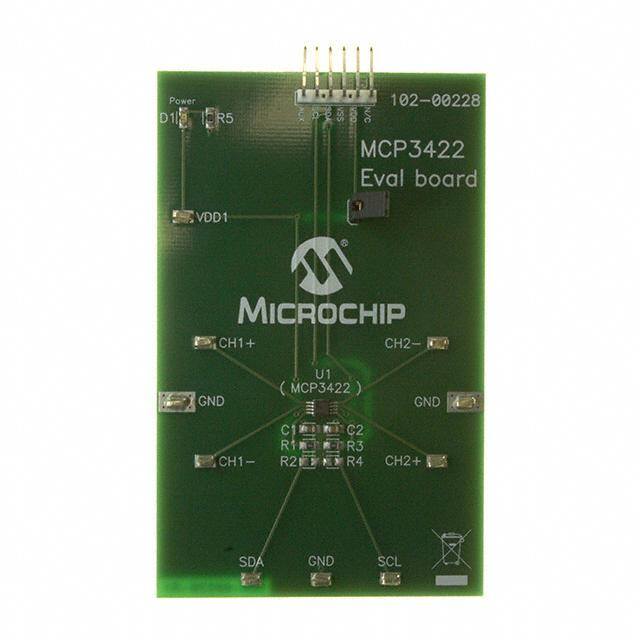
 Datasheet下载
Datasheet下载

